Descending a ski run at Greek Peak en route to the next aid station
It gives me great pleasure to write this final Physical Challenge update, for week #20. After 5 months of training – and 5 months of blogging about training as a gluten-free athlete – the big Virgil Crest Ultra race is in the bag.
As planned, the week leading up to the race on Saturday, September 25 (two days ago), was mostly restful, with one short 3.5-mile run on Wednesday just keep my legs “awake.” Otherwise, I was all about letting my legs fully recover from training so they’d be good and fresh for the main event. My goal was to finish the race in 10-12 hours, knowing that 10 hours would be a big stretch, and that 12 hours was a more realistic target.
On Thursday, we drove up to Ithaca, NY from Long Island, so that I’d have Friday for my legs to bounce back from sitting in the car for five or so hours. From a GF nutrition standpoint (and as I believe I’ve written before) I personally don’t like to heavily carbo load the night before a race, as many athletes do. I much prefer to maintain my normal, balanced diet. I don’t want to do anything that’s going to upset my body, to throw off my digestion. I simply want to maintain an even keel.
Friday night, however, things went south in what could have been a disastrous turn of events. Dinner was chicken and rice. I cleaned my plate and immediately headed out the door for the 30-45 minute drive to the race location for race packet pickup and an athletes meeting. I barely made it there before I had to disappear into the restroom. I knew the feeling all too well. Gluten cross-contamination. Dinner went straight through me. So did anything else I ate that night. This was decidedly not good.
Arriving at aid station #8, mile 40.6
I woke around 4:30am on race morning, planning to leave the house at 4:45, and arrive at the race around 5:30, half an hour before the 6:00am start. Breakfast – yogurt, GF cereal, some fresh fruit, and a slice of GF bread – also went straight through me. In fact, between the time I arrived at the race venue and when the race started, I had to run to the bathroom three times, including once just 3 minutes before the race started. I made it to the starting line 45 seconds before race director Ian Golden blew on a ram’s horn to send us off. Just before I toed the line, I grabbed a handful of napkins from the finish line aid station and stuffed them into my Camelbak backpack, hoping I wouldn’t need them, but worried that I might.
Apart from my digestive troubles, I approached the start of this race differently than most every other race I’ve done. Usually, I might listen to some psych up music, and get myself pumped up for the race. You know, get the adrenaline going. Which is exactly what I didn’t want to do for this race. I wasn’t nervous. Sure, I was excited and ready to race. But to the best of my ability, I tried to make the race start anti-climactic. Too much adrenaline at the race start would cause me to go out too hard, too fast. But the length and difficulty of the race demanded a different approach – a slow and steady mentality. You needed to be able to maintain your pace for the long-haul, or else risk bonking and dropping out of the race before the finish.
With the 6:00am start, it was still dark when we began running. Most of us ran with small LED headlamps or small handheld flashlights. Running in the dark, especially with other runners around you, is a funny thing. Because you don’t see the terrain around you as well, your perception is off. You feel like you’re running faster than you are. You lift your feet up higher instinctively to hopefully avoid tripping on an unseen root or rock. You struggle to find the right pace…not the pace of the people around you, or the pace you think you’re going.
Changing into a fresh pair of socks and fresh trail running sneakers
(while Marin eats a GF chocolate chip cookie)
By the second leg of the race – miles 5.4 to 10.8 – I had to duck into the woods and make use of those napkins I had stashed in my pack. I lost several precious minutes as a pack of runners passed me by. I caught and re-passed them a few miles later, but my bigger concern was my own health. If I couldn’t keep calories going in (and staying in), then I knew I was in for a very bad day, and almost certainly wouldn’t finish the race.
Thankfully, my gluten cross-contamination episode was very mild. I experienced none of the acute abdominal pain, muscle trembles, or fatigue that usually accompanied such events. By the fourth leg of the race – miles 14.7 to 20.7 – food and fluids were finally going in…and most importantly, staying in. I breathed a huge sigh of relief, and as I kept the calories going in, I began to feel better and better.
My plan for race nutrition was pretty straightforward. Water in the Camelbak while running. Gatorade while moving through the aid stations. GUs and energy chews while running. M&Ms (for chocolate), oranges, bananas, GF bread slices, GF cinnamon scones, GF chocolate chip cookies, and bacon (for salt) at the aid stations. Kelli served as my support crew, baking all the GF stuff on Friday, and shuttling a bag with all the goodies from aid station to aid station. The GUs provided quick, easy energy while running. The solid foods helped to settle my stomach, and to moderate blood sugar spikes and dips that come with consuming only GU-like products. In hindsight, the only thing I’d change would be to bring more savory foods. So many of my foods were on the sweeter side, and as the miles ticked by, it became harder and harder to stomach the idea of eating another GU gel packet. For the first half of the race or so, I focused on eating every 45 minutes to 1 hour. But for the second half of the race, I took in calories every 20-30 minutes, which proved crucial for maintaining some kind of energy level.
The course itself was gorgeous. Most of the route followed the Finger Lakes Trail, which – despite being a New York native – I’ve never hiked before. Open forests of beech, oak and maple. Stands of hemlock. Fern-covered hillsides. Fall colors were already abundant in places. Streams and little glens and ravines. And of course, the never-ending hills, which totaled 10,000 vertical feet of ascent, and an equal amount of descent, over the length of the race.
Coming home to the finish line
By the fourth aid station at mile 20.7, the field – including 48 starting runners in the 50-mile race – had gotten quite strung out. (Fittingly, 50 runners had originally registered for the 50-miler, but 2 didn’t start the race…) Every ultra runner has his or her own strengths and style of running. Some power up the uphills. Others bomb the descents. My strength comes in being able to maintain a given pace over a very long distance. In general, the longer a race, the more it benefits me, and the more racers I tend to pass (who had sped ahead of me earlier in the race).
Amazingly, though, I kept running into (sorry, couldn’t resist the running pun…) two of the same people: my friend, Tom, from Boston, and Dan, a PhD student from Cornell (I later learned). Tom and I registered for the race on the same day, but had trained independently, since he’s in MA and I’m in CO. A few weeks before the race, we did one long training run together while he was in CO for business, and during that run I got the sense that we were pretty evenly matched going into this race. Now, that suspicion was playing out. We overlapped at the first 7 (of 10) aid stations. We often were in sight of each other on the trails, sometimes me ahead of Tom, sometimes vice versa, and sometimes we ran together.
It was interesting to see our different approaches to aid stations. Tom treated them like triathlon transitions, moving through as quickly as possible, and doing more of his eating out on the trails. I treated aid stations more like gas stations, stopping to refuel, plus park your car and go into the mini-mart for some food. I would refill my hydration bladder, swig gatorade, restock on packets of GU, eat some solid food, and stretch my legs. I almost always left the aid stations a few minutes behind Tom, but miles later, I would always catch him, and then we’d repeat the cycle at the next aid station.
I could not have asked for better race conditions. Some 80% of the course was shaded. Skies were partly sunny, partly cloudy. A light breeze blew. The high temperature was in the low 60s. In other words, it was ideal weather for my body.
Done, in more ways than one, at mile 51.4, after 11 hours 43 minutes
Coming into the turn around – aid station #5 at Daisy Hollow, mile 25.7 – the out-and-back format of the course allowed me to gauge my place in the race. Anyone heading in the opposite direction in theory was ahead of me (unless they later dropped out of the race, which happened in at least one instance). I knew I was somewhere around the top 10 at that point, but there was a lot of race left, and anything could happen. After all, when I reached Kelli at aid station #6, mile 30.7, I was entering virgin territory. Every step I took from that point would be farther than I’ve ever run in a single push before.
As the miles ticked by, I grew more and more tired. More parts of my body began to ache. My quads and calved screamed. My knees dreaded the downhills. My feet hurt from constantly flexing over all the gnarled roots along the trail. And yet, I kept going. I found that running this kind of distance became a matter of sticking to my routine. Run the flats and downhills. Jog the gradual uphills. Power hike the steeper uphills. Eat every 30 minutes. Constantly sip water. Refuel at aid stations. You reach a point beyond pain and beyond exhaustion, where you simply keep on going, because that’s what you’ve been doing for the last 40 miles and the last 8 or 9 hours. So you do it some more.
Leaving each aid station, race organizers had also posted “inspiring” quotes to help motivate you for the next leg of the race. Sayings such as: “Pain is temporary, but quitting lasts forever.” And “Pain is inevitable. Misery is optional.” Words of wisdom, huh?
Against all odds, especially in light of how I’d been feeling the night before and morning of, the race was going according to plan. I’d drawn up a spreadsheet for the race that listed a range of per mile pace times, split times for each leg of the race, and anticipated arrival times for each aid station. I gave the printout to Kelli, so she could chart my progress and give me feedback for how I was doing. By all measures, I was doing well.
Even so, I had to remind myself that this was a monumental effort, unlike anything I’d ever done. (Tom later commented that the Virgil Crest Ultra was harder than an Ironman triathlon, which he’s finished.) I had to remember that – first and foremost – I was racing against myself, and racing against the course. I couldn’t worry about what other people were doing. If I saw a runner ahead of me, I couldn’t concern myself with catching and passing them. If I looked behind me and saw a runner coming, I couldn’t concern myself with them catching and passing me. Of course, I did it anyway. I’m too competitive not to. As much as I say I’d like to just race for fun, or just finish, in any race I’ve ever done, I push myself as hard as I can.
With the hours and miles ticking by, my focus became three goals: 1) race within myself, so I wouldn’t cramp up or get injured and have to withdraw, 2) finish with a sub-12-hour time, and 3) preserve a top 10 finish.
Marin, reminding me to keep drinking
During section 7 of the race, which involved a lot of steep elevation gain, my legs felt like lead weights. If I couldn’t have looked down and seen my own two feet, I would have sworn someone had strapped 5 or 10 pound plates to each foot. Coming in to aid station #8, mile 40.6, Kelli was now joined by the rest of the family, who’d shown up to cheer me on for the final 11 miles. They also brought the camera, which we’d forgotten and left behind, so all of the pictures in this post are from aid station #8 and the finish line… (By now, Tom’s legs had unfortunately cramped up, and he was forced to walk the last two legs of the race…but he still finished. Awesome determination.)
I took a longer break at the aid station than usual. My 3-4 minute transitions became a 7-minute transition, during which I changed into a fresh pair of socks and trail running sneakers, and really loaded up on the calories. Leaving the aid station for the second to last leg of the race, I felt as if I’d found another wind (my 5th or 6th?). I powered through leg #9, and at the 9th aid station, the spreadsheet Kelli carried showed that I was still remarkably on pace.
And then, there was just one leg of the race left to run, with a net downhill elevation change. I could sense the finish line growing nearer, which buoyed my spirits. Even throughout the race, and despite the pain and exhaustion, I was truly enjoying myself…Kelli, the family, the volunteers, the beautiful setting, the growing sense of accomplishment, the other runners – who were all mutually supportive and quite nice – made for an awesome race experience.
In the final miles of the race, I caught and passed 2 other 50-milers. It was then that the mutually supportive nature of the race really shined. I was running alongside a 100-miler, clearly 10 years or more my senior. When I reached my finish line, he was going to turn around and do the whole thing a second time. He turned to me and said, “Come on. We’re going to pick up the pace and get you home in under 7 minutes. We can do it.” He continued: “Those other two guys won’t catch you.” He clearly knew the course, knowing each turn, each subtle downhill or uphill. He told me when to open up my stride, when to pick up my cadence and leg turnover. If I began to slip behind, he encouraged me to catch back up to him, and each time I did, he told me “That’s it. Nice job. Keep it up.” As we rounded the final turn, with nothing but a straight stretch of green grass to the finish, he slowed up and simply said, “You’ve got it from here.”
I crossed the finish line in 11 hours 43 minutes, in 7th place. I reached each and every one of my three goals. Thanks, in part, to that runner who brought more out of me than I thought I had in myself. I’m sure that last 3/4 of a mile was the fastest split of the day for me…at the end of a 51.4 mile run with 10,000 feet of elevation gain!
Kelli, Marin, Charlotte and lots of other family were there to welcome me across the finish line. Before I walked over to give Kelli a kiss and a hug, and to pick up Marin, I first turned around and thanked that 100-miler for his help, and then cheered as Dan – the Cornell geologist – crossed the finish line 3 minutes behind me. We’d seen each other all day, and it seemed only fitting that we finished the race more or less together.
At the end of the day, the race stats broke down as follows:
Miles: 51.4
Elevation Gain: 10,000 vertical feet
Registered runners: 50
Starters: 48
Finishers: 33
My place: 7th
My time: 11 hours 43 minutes
Fluids consumed: ~14 liters
About 20 minutes after the race, the adrenaline that sustained me across the finish line subsided, and my energy level and overall feeling crashed. I was done. Tom crossed the finish line a little while later. He, too, was now a 50-mile finisher.
As for the fundraising effort in support of the National Foundation for Celiac Awareness, I was overwhelmed by the outpouring of support in the final days leading up to the race. Donations are still trickling in, but as of this morning, we’ve raised nearly $3,600 for the NFCA. Thank you to everyone who made it happen! It is our collective success.
Now, I’m in rest, recovery and healing mode. When I crossed the finish line, Marin looked up at me and said, “Daddy run?” Yes, Daddy run. But not again for at least a couple of weeks.
– Pete
P.S. Huge thanks this week go out to Debbie B., Levon K., Nancy A., Sally C., Kevin M., Kendra N., Jonathan A., Danny O., John F., Maureen S., Paula N., Patti S., Nancy P., David K., Lisa B., Beth E., Lisa S., Rachel W., Jessica M., Lou E., Mary G., Jan C., and Jackie R. for your generous donations!
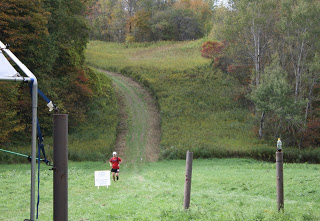
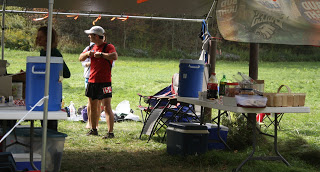
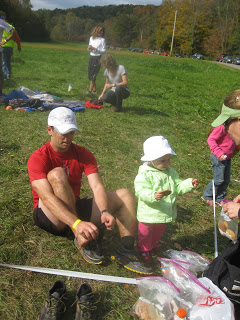
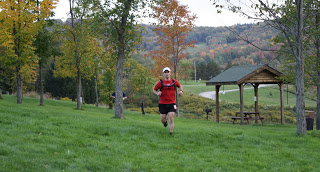
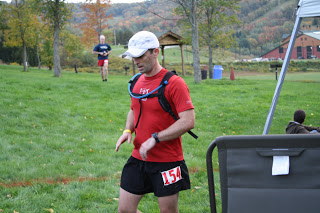
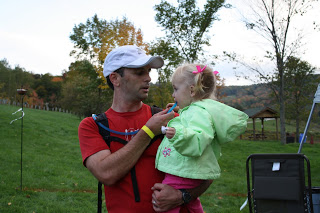
CONGRATS!!!!
Wow! Awesome work! Glad that CC didn’t ruin things for you! I bet you’re enjoying putting your feet up a bit now 🙂
Wow, Pete–what an event and truly a phenomenal finish given the cross contamination issues! I hope you are basking in the glow of success still–woohoo!
Congrats on both your success in the event and the fundraising! 🙂
Shirley
Thanks Steve!!
Thanks Stephanie! Yes, I’m very much enjoying NOT running at the moment, though unbelievably, I’m already thinking about doing one of these races again… (though not until I’ve fully healed up of course).
Thanks Shirley! Yeah, the mild CC had me really worried for the first 10 miles of the race. My day could have gone VERY differently. Thank goodness it worked out the way it did. I was 15 minutes off of a top 5 finish. I wonder if that might have been a possibility without my early digestive troubles during the race…
Cheers, Pete
Great job! I can’t believe what you had to deal with the night before and the morning of. You are an inspiration to all who have to experience such things.
And please consider keeping your readers in the loop for your next event training. It really is fun to read.
Oh, over the weekend I checked your original “I’ll take the physical challenge” post from way back when. At that time you hoped to do an xterra in June. Were you able to get that in? I don’t remember whether you wrote about anything like that.
Great job!